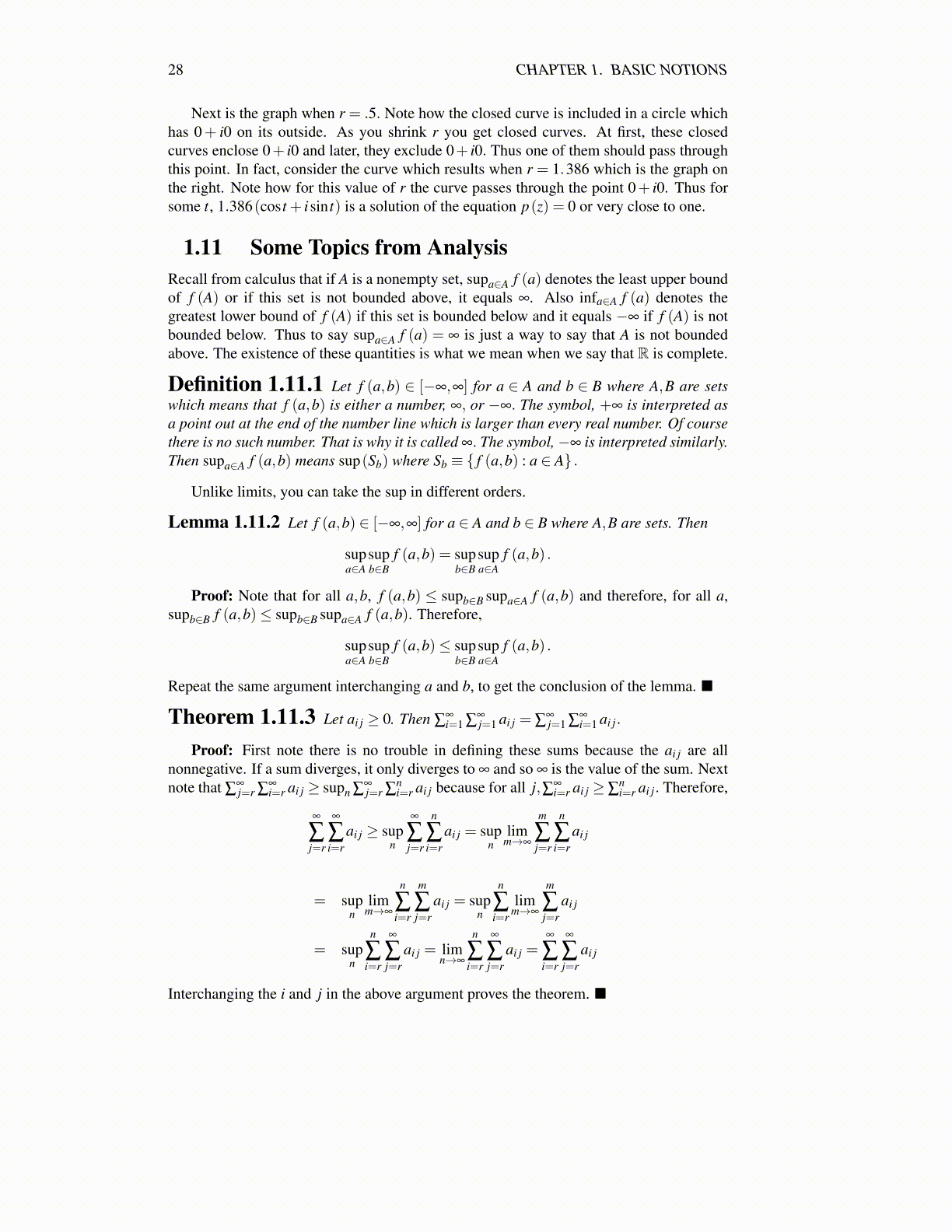
28 CHAPTER 1. BASIC NOTIONS
Next is the graph when r = .5. Note how the closed curve is included in a circle whichhas 0+ i0 on its outside. As you shrink r you get closed curves. At first, these closedcurves enclose 0+ i0 and later, they exclude 0+ i0. Thus one of them should pass throughthis point. In fact, consider the curve which results when r = 1.386 which is the graph onthe right. Note how for this value of r the curve passes through the point 0+ i0. Thus forsome t, 1.386(cos t + isin t) is a solution of the equation p(z) = 0 or very close to one.
1.11 Some Topics from AnalysisRecall from calculus that if A is a nonempty set, supa∈A f (a) denotes the least upper boundof f (A) or if this set is not bounded above, it equals ∞. Also infa∈A f (a) denotes thegreatest lower bound of f (A) if this set is bounded below and it equals −∞ if f (A) is notbounded below. Thus to say supa∈A f (a) = ∞ is just a way to say that A is not boundedabove. The existence of these quantities is what we mean when we say that R is complete.
Definition 1.11.1 Let f (a,b) ∈ [−∞,∞] for a ∈ A and b ∈ B where A,B are setswhich means that f (a,b) is either a number, ∞, or −∞. The symbol, +∞ is interpreted asa point out at the end of the number line which is larger than every real number. Of coursethere is no such number. That is why it is called ∞. The symbol,−∞ is interpreted similarly.Then supa∈A f (a,b) means sup(Sb) where Sb ≡ { f (a,b) : a ∈ A} .
Unlike limits, you can take the sup in different orders.
Lemma 1.11.2 Let f (a,b) ∈ [−∞,∞] for a ∈ A and b ∈ B where A,B are sets. Then
supa∈A
supb∈B
f (a,b) = supb∈B
supa∈A
f (a,b) .
Proof: Note that for all a,b, f (a,b) ≤ supb∈B supa∈A f (a,b) and therefore, for all a,supb∈B f (a,b)≤ supb∈B supa∈A f (a,b). Therefore,
supa∈A
supb∈B
f (a,b)≤ supb∈B
supa∈A
f (a,b) .
Repeat the same argument interchanging a and b, to get the conclusion of the lemma. ■
Theorem 1.11.3 Let ai j ≥ 0. Then ∑∞i=1 ∑
∞j=1 ai j = ∑
∞j=1 ∑
∞i=1 ai j.
Proof: First note there is no trouble in defining these sums because the ai j are allnonnegative. If a sum diverges, it only diverges to ∞ and so ∞ is the value of the sum. Nextnote that ∑
∞j=r ∑
∞i=r ai j ≥ supn ∑
∞j=r ∑
ni=r ai j because for all j,∑∞
i=r ai j ≥∑ni=r ai j. Therefore,
∞
∑j=r
∞
∑i=r
ai j ≥ supn
∞
∑j=r
n
∑i=r
ai j = supn
limm→∞
m
∑j=r
n
∑i=r
ai j
= supn
limm→∞
n
∑i=r
m
∑j=r
ai j = supn
n
∑i=r
limm→∞
m
∑j=r
ai j
= supn
n
∑i=r
∞
∑j=r
ai j = limn→∞
n
∑i=r
∞
∑j=r
ai j =∞
∑i=r
∞
∑j=r
ai j
Interchanging the i and j in the above argument proves the theorem. ■